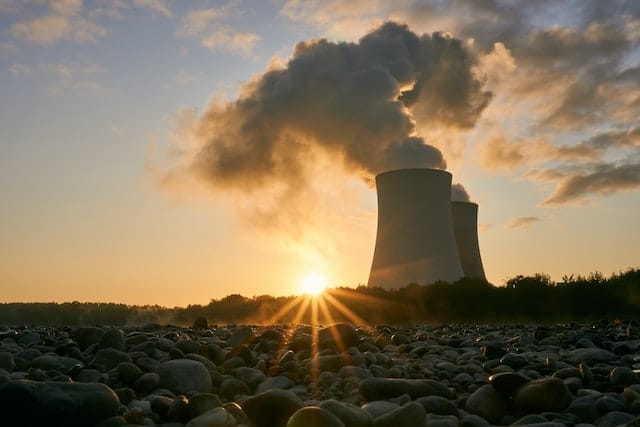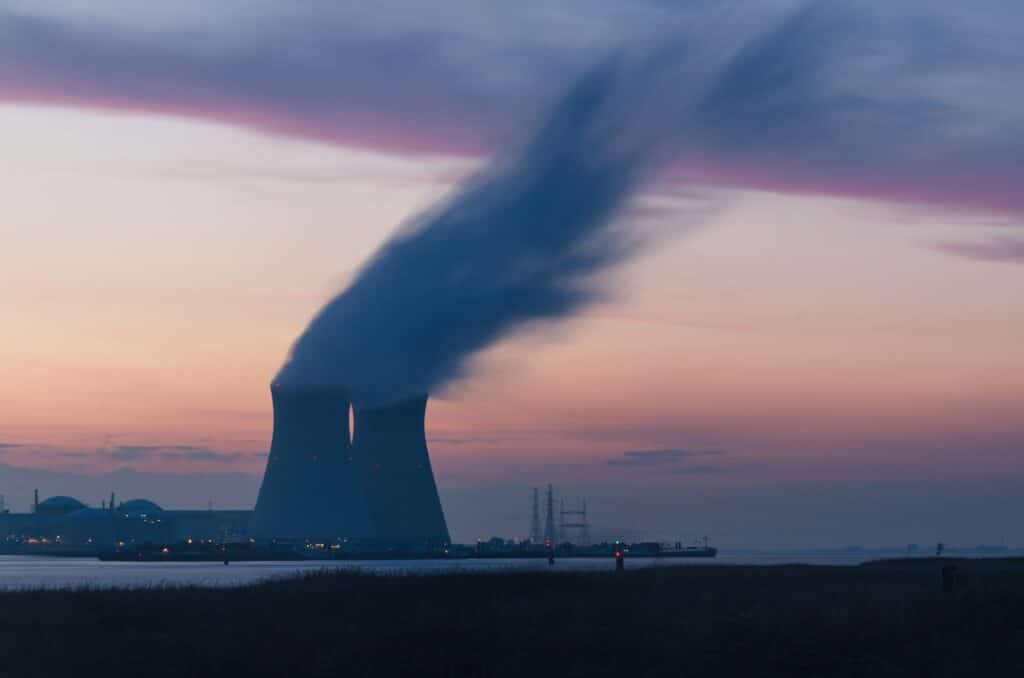Introduction – Nuclear Fuel Is Finite
Nuclear energy is considered non-renewable because it relies on the use of finite resources, such as uranium and plutonium, to produce energy. These resources are limited and cannot be replenished once they are used up. In contrast, renewable energy sources, such as solar and wind power, are constantly replenished and can be used indefinitely.
The amount of nuclear fuel left in the Earth is, for all intents and purposes, infinite because it will take thousands of years to deplete all uranium (see below).

Basics Of Nuclear Energy
Nuclear energy is produced through the process of nuclear fission, in which the nucleus of an atom is split into smaller nuclei, releasing a large amount of energy in the process. This process requires a fuel source, such as uranium or plutonium, which undergoes a controlled chain reaction to produce heat. This heat is then used to generate steam, which is used to power a turbine and generate electricity.
While nuclear energy can provide a large amount of clean, reliable energy, it has several disadvantages. One of the main drawbacks is that the fuel sources used in nuclear power plants are non-renewable and will eventually be depleted. Additionally, the process of nuclear fission produces radioactive waste, which must be carefully managed and disposed of in order to prevent environmental contamination. For these reasons, many people consider nuclear energy to be a non-renewable energy source.
In late 2022 the National Ignition Facility achieved a milestone of sorts in recovering more energy from a fusion reaction than was spent. The design of the reactor was such that the total cost would have been prohibitive for commercial use. Now the race continues to either re-engineer the design of the NIF success to make it profitable or see whether other reactor designs will be energy positive as well.
Nuclear Energy Is Special Because It Emits No Carbon

Despite the fact that nuclear energy is non-renewable like petroleum, natural gas etc, nuclear energy is quite special. Nuclear energy is considered special because it is one of the most efficient and clean sources of energy currently available. It produces very little greenhouse gases, and the waste products it generates are relatively small in comparison to other forms of energy production.
Additionally, nuclear energy is a highly reliable and stable source of energy, making it an attractive option for many countries around the world. Nuclear energy is a form of energy that is produced by the process of nuclear fission, which is the splitting of atomic nuclei. This process releases a large amount of energy, which can be harnessed to generate electricity or to power a variety of other applications.
Nuclear energy is not without its drawbacks, including the potential risks associated with nuclear accidents and the disposal of nuclear waste.
Common Nuclear Fuel Sources
The most common nuclear fuel sources are uranium and plutonium. These elements are used in the process of nuclear fission, in which the nucleus of an atom is split into smaller nuclei, releasing a large amount of energy in the process.
Uranium is the most commonly used fuel source in nuclear power plants. It is a naturally occurring element that can be found in small amounts in the Earth’s crust. Uranium is commonly mined from ore deposits and then processed into a form called uranium oxide, or “yellowcake,” which is then enriched to increase the concentration of the fissile isotope uranium-235. This enriched uranium is then used as fuel in nuclear power plants.
Plutonium is another commonly used fuel source in nuclear power plants. It is a synthetic element that is produced through the process of nuclear transmutation, in which the nucleus of an atom is changed into another element by exposing it to high-energy particles. Plutonium can be produced in a nuclear reactor by exposing natural uranium or depleted uranium to neutron radiation. It can also be produced in a particle accelerator by bombarding other elements with high-energy protons. Plutonium is used as fuel in some types of nuclear reactors, including fast breeder reactors and some types of research reactors.
How Much Nuclear Fuel Is Left
Since nuclear energy is non-renewable you might want to know how much fuel is left? Will we run out in the next hundred years like petroleum and natural gas? It is quite hard to answer exactly this question as the exact amount of uranium left on Earth is unknown. Estimates suggest that there may be around 4.5 billion tons of uranium still available in the Earth’s crust.
What is the rate of uranium fuel usage? The rate of uranium fuel usage globally is estimated to be around 66,000 metric tons per year. This fuel is used to generate electricity in nuclear power plants. At this rate, it will take about 60,000 to 70,000 years to deplete all uranium. As for plutonium, this is created as a by-product of Uranium so the answer will be similar.
What Will We Do When We Run Out Of Uranium?
Uranium is non-renewable so we may indeed run out one day. After that we will still be carry out fusion if the technology is developed. Fusion fuel comes from water, which is abundant on Earth. Nuclear fusion is a process in which atomic nuclei combine to form a heavier nucleus, releasing a large amount of energy in the process.
This process is the opposite of nuclear fission, which is the process by which atomic nuclei are split to release energy. Nuclear fusion has several potential advantages over nuclear fission as a source of energy, including the following:
- Nuclear fusion reactions produce much more energy than nuclear fission reactions, meaning that a smaller amount of fuel is needed to generate the same amount of energy.
- Nuclear fusion reactions produce very little radioactive waste, which means that the waste products can be safely disposed of without posing a significant risk to human health or the environment.
- Nuclear fusion reactions do not produce greenhouse gases, making it a clean and environmentally friendly source of energy.
- Nuclear fusion reactions are much safer than nuclear fission reactions, as they do not have the potential to undergo a catastrophic meltdown.
Nuclear fusion technology is still in the early stages of development, and there are many challenges that need to be overcome before it can be used as a practical source of energy. These challenges include the development of fusion reactors that can generate more energy than they consume, and the development of materials that can withstand the extremely high temperatures and pressures that are required for fusion reactions to occur.

Anne Lauer
Anna Lauer is a writer, gardener, and homesteader living in rural Wisconsin. She has written for Mother Earth News, Grit, and Hobby Farms magazines. Anna is writing a new book about growing your food for free and an ultimate guide to producing food at little to no cost. When she’s not writing or gardening, Anna enjoys spending time with her husband and two young daughters.
